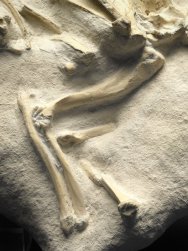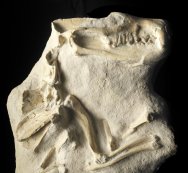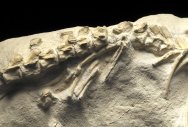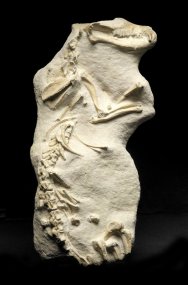 Description:
Let the photos speak for themselves regarding the visual impact
of this stunning specimen. This is truly a remarkable museum grade
fossil find of an Oligocene find Hyaenodon (meaning "hyaena-toothed").
Though White River mammal fossils are not uncommon, mostly complete
skeletons are rare, and Hyaenodons rarer still. Preserved are the
skull, backbone, ribs, front legs, shoulder blade and sections of
the back legs. Need I mention how many hours of conservation went
into preparing this specimen? While some fossil dealers throw around
the term “museum quality” and “centerpiece”,
like confetti, this one, in my opinion, unequivocally deserves such
an accolade. Description:
Let the photos speak for themselves regarding the visual impact
of this stunning specimen. This is truly a remarkable museum grade
fossil find of an Oligocene find Hyaenodon (meaning "hyaena-toothed").
Though White River mammal fossils are not uncommon, mostly complete
skeletons are rare, and Hyaenodons rarer still. Preserved are the
skull, backbone, ribs, front legs, shoulder blade and sections of
the back legs. Need I mention how many hours of conservation went
into preparing this specimen? While some fossil dealers throw around
the term “museum quality” and “centerpiece”,
like confetti, this one, in my opinion, unequivocally deserves such
an accolade.
The
badlands of the western US are particularly rich in 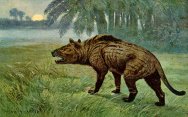 mammal
fossils from the late Eocene to Miocene. The Brule Formation is
exposed over a huge area including Nebraska, North and South Dakota,
Wyoming, and Colorado, and yields abundant fossils as layers are
eroded. This diverse group of stocky prehistoric mammals grazed
amid the grasslands, prairies or savannas of North and Central America
throughout much of the Cenozoic era. mammal
fossils from the late Eocene to Miocene. The Brule Formation is
exposed over a huge area including Nebraska, North and South Dakota,
Wyoming, and Colorado, and yields abundant fossils as layers are
eroded. This diverse group of stocky prehistoric mammals grazed
amid the grasslands, prairies or savannas of North and Central America
throughout much of the Cenozoic era.
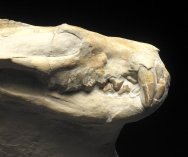 Hyaenodons
belong to an extinct group of mammals called creodonts that were
a dominant and diverse group of mammalian predators during the Eocene
and Oligocene.
There are two families of creodonts. The oxyaenids were generally
small-bodied forms
with short limbs that became extinct at the end of the Eocene. The
Hyaenodontidae (named by Leidy) had longer limbs. They were more
diverse, longer-lived and more widely distributed. Hyaenodonts were
greatly reduced in the late Oligocene, but one genus from Asia survived
into the Pliocene. Hyaenodons
belong to an extinct group of mammals called creodonts that were
a dominant and diverse group of mammalian predators during the Eocene
and Oligocene.
There are two families of creodonts. The oxyaenids were generally
small-bodied forms
with short limbs that became extinct at the end of the Eocene. The
Hyaenodontidae (named by Leidy) had longer limbs. They were more
diverse, longer-lived and more widely distributed. Hyaenodonts were
greatly reduced in the late Oligocene, but one genus from Asia survived
into the Pliocene.
Creodonts
were more primitive than the true carnivores. Although their teeth
were clearly adapted for eating meat, they were less specialized
than those of the carnivores. Their limbs were also not as well
adapted for running. Many paleontologists believe that they were
unable to cope with the faster ungulates that appeared at the beginning
of the Miocene.
Please
note that a specially prepared metal display stand will accompany
this Hyaenodon with the purchase.
|



